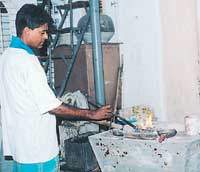|
Jewellery & Gems
By Quintus
Perera This is true
for the likes of Sudharma de Silva and generations of her family,
originally from Galle who have been turning out hand-made jewellery. It may have
been due to the family affiliations with this industry that she
developed a liking to it since she was a young adult, particularly
in the designing process. Ms. de Silva often visits Galle where there are dozens of jewellery craftsmen whose lifetime occupation is designing and turning out jewellery from skills handed down by their ancestors. In addition to selecting items from there, she also has a workshop in Dehiwela where around 15 are employed turning out all kinds of hand-made jewellery. Apart from precious and semi-precious stones, she also deals with yellow and white gold and diamond settings for very expensive ornaments. She laments that one of the biggest problems is the lack of support and understanding for the art of hand-made jewellery, completely ignored by local authorities. She says there are a large number of brilliant gold smiths whose work could easily be sold in any part of the world. "I sell some of their stuff straight from the village to international buyers." Finding it difficult to break into the international market at first - also due to lack of a support mechanism by the state - she relied on the generosity of Hubert Jayakody, a Sri Lankan businessman, who helped her showcase her products in exhibitions in places like Brisbane, Canada, Japan and Australia. By 1990 she was able to attend exhibitions with Export Development Board (EDB) sponsorship in New York, Las Vegas, Japan and Germany. Her main buyers come from the US. Current trends globally show a liking for white gold and also conventional gold settings. With annual sales in the region of two million rupees with a portion going to the Gem Corporation, banks, insurance etc and costs of foreign travel, Ms. de Silva is now more keen on the jewellery industry as a hobby and past time rather than profiting from it. She is particularly keen to improve the plight of traditional craftsmen many of whom come from the south. In Galle, almost the entire village of Madapatha is engaged in gold smithy with many of these villagers rarely benefiting from the generous prices fetched overseas for their works of art. Ms. de Silva believes small scale gold smiths and jewellery makers should not only be exposed to foreign markets but also exposed to the use of modern equipment and provided adequate training. She has made several appeals to commerce and trade ministers during various regimes without success. "How can these poor people take part in exhibitions when they have to pay for air fare which alone would cost around Rs. 60,000 to 100,000 and staying in hotels is so costly," she added. |
||||
Copyright © 2001 Wijeya Newspapers
Ltd. All rights reserved. |
